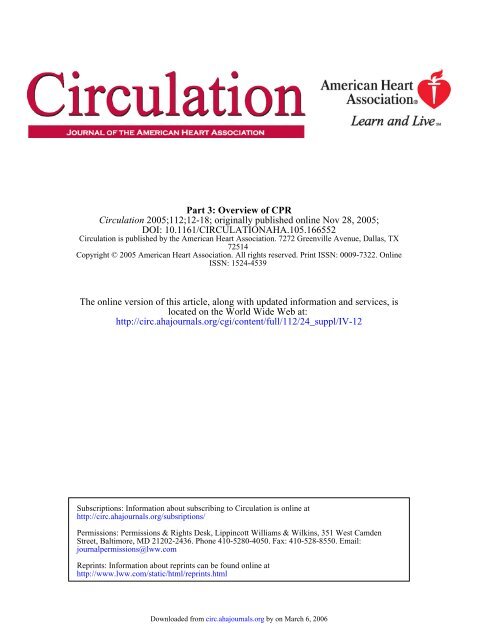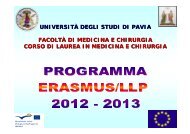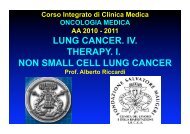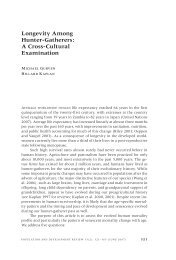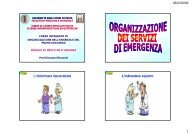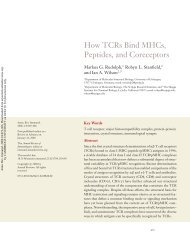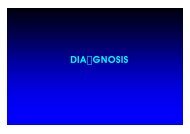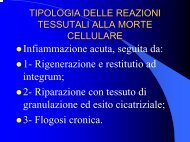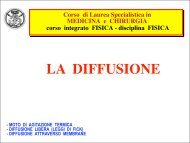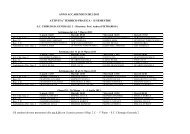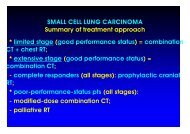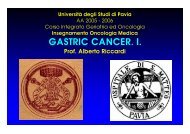Overview of CPR
Overview of CPR
Overview of CPR
Create successful ePaper yourself
Turn your PDF publications into a flip-book with our unique Google optimized e-Paper software.
Part 3: <strong>Overview</strong> <strong>of</strong> <strong>CPR</strong><br />
Circulation 2005;112;12-18; originally published online Nov 28, 2005;<br />
DOI: 10.1161/CIRCULATIONAHA.105.166552<br />
Circulation is published by the American Heart Association. 7272 Greenville Avenue, Dallas, TX<br />
72514<br />
Copyright © 2005 American Heart Association. All rights reserved. Print ISSN: 0009-7322. Online<br />
ISSN: 1524-4539<br />
The online version <strong>of</strong> this article, along with updated information and services, is<br />
located on the World Wide Web at:<br />
http://circ.ahajournals.org/cgi/content/full/112/24_suppl/IV-12<br />
Subscriptions: Information about subscribing to Circulation is online at<br />
http://circ.ahajournals.org/subsriptions/<br />
Permissions: Permissions & Rights Desk, Lippincott Williams & Wilkins, 351 West Camden<br />
Street, Baltimore, MD 21202-2436. Phone 410-5280-4050. Fax: 410-528-8550. Email:<br />
journalpermissions@lww.com<br />
Reprints: Information about reprints can be found online at<br />
http://www.lww.com/static/html/reprints.html<br />
Downloaded from<br />
circ.ahajournals.org by on March 6, 2006
We have always known that <strong>CPR</strong> is not a single skill but a<br />
series <strong>of</strong> assessments and interventions. More recently<br />
we have become aware that cardiac arrest is not a single problem<br />
and that the steps <strong>of</strong> <strong>CPR</strong> may need to vary depending on the<br />
type or etiology <strong>of</strong> the cardiac arrest. At the 2005 Consensus<br />
Conference researchers debated all aspects <strong>of</strong> detection and<br />
treatment <strong>of</strong> cardiac arrest. Yet the last summation returned to<br />
the beginning question: how do we get more bystanders and<br />
healthcare providers to learn <strong>CPR</strong> and perform it well?<br />
Epidemiology<br />
Sudden cardiac arrest (SCA) is a leading cause <strong>of</strong> death in the<br />
United States and Canada. 1–3 Although estimates <strong>of</strong> the<br />
annual number <strong>of</strong> deaths due to out-<strong>of</strong>-hospital SCA vary<br />
widely, 1,2,4,5 data from the Centers for Disease Control and<br />
Prevention estimates that in the United States approximately<br />
330 000 people die annually in the out-<strong>of</strong>-hospital and emergency<br />
department settings from coronary heart disease. About<br />
250 000 <strong>of</strong> these deaths occur in the out-<strong>of</strong>-hospital setting. 1,6<br />
The annual incidence <strong>of</strong> SCA in North America is 0.55 per<br />
1000 population. 3,4<br />
Cardiac Arrest and the Chain <strong>of</strong> Survival<br />
Most victims <strong>of</strong> SCA demonstrate ventricular fibrillation (VF) at<br />
some point in their arrest. 3–5 Several phases <strong>of</strong> VF have been<br />
described, 7 and resuscitation is most successful if defibrillation is<br />
performed in about the first 5 minutes after collapse. Because the<br />
interval between call to the emergency medical services (EMS)<br />
system and arrival <strong>of</strong> EMS personnel at the victim’s side is<br />
typically longer than 5 minutes, 8 achieving high survival rates<br />
depends on a public trained in <strong>CPR</strong> and on well-organized<br />
public access defibrillation programs. 9,10 The best results <strong>of</strong> lay<br />
rescuer <strong>CPR</strong> and automated external defibrillation programs<br />
have occurred in controlled environments, with trained, motivated<br />
personnel, a planned and practiced response, and short<br />
response times. Examples <strong>of</strong> such environments are airports, 9<br />
airlines, 11 casinos, 12 and hospitals (see Part 4: “Adult Basic Life<br />
Support”). Significant improvement in survival from out-<strong>of</strong>hospital<br />
VF SCA also has been reported in well-organized police<br />
<strong>CPR</strong> and AED rescuer programs. 13<br />
<strong>CPR</strong> is important both before and after shock delivery.<br />
When performed immediately after collapse from VF SCA,<br />
<strong>CPR</strong> can double or triple the victim’s chance <strong>of</strong> survival. 14–17<br />
<strong>CPR</strong> should be provided until an automated external defibrillator<br />
(AED) or manual defibrillator is available. After about 5<br />
minutes <strong>of</strong> VF with no treatment, outcome may be better if<br />
shock delivery (attempted defibrillation) is preceded by a<br />
period <strong>of</strong> <strong>CPR</strong> with effective chest compressions that deliver<br />
(Circulation. 2005;112:IV-12-IV-18.)<br />
© 2005 American Heart Association.<br />
This special supplement to Circulation is freely available at<br />
http://www.circulationaha.org<br />
DOI: 10.1161/CIRCULATIONAHA.105.166552<br />
Part 3: <strong>Overview</strong> <strong>of</strong> <strong>CPR</strong><br />
IV-12<br />
some blood to the coronary arteries and brain. 18,19 <strong>CPR</strong> is also<br />
important immediately after shock delivery; most victims<br />
demonstrate asystole or pulseless electrical activity (PEA) for<br />
several minutes after defibrillation. <strong>CPR</strong> can convert these<br />
rhythms to a perfusing rhythm. 20–22<br />
Not all adult deaths are due to SCA and VF. An unknown<br />
number have an asphyxial mechanism, as in drowning or drug<br />
overdose. Asphyxia is also the mechanism <strong>of</strong> cardiac arrest in<br />
most children, although about 5% to 15% have VF. 23–25<br />
Studies in animals have shown that the best results for<br />
resuscitation from asphyxial arrest are obtained by a combination<br />
<strong>of</strong> chest compressions and ventilations, although chest<br />
compressions alone are better than doing nothing. 26,27<br />
Differences in <strong>CPR</strong> Recommendations by Age<br />
<strong>of</strong> Victim and Rescuer<br />
Simplification<br />
The authors <strong>of</strong> the 2005 AHA Guidelines for <strong>CPR</strong> and ECC<br />
simplified the BLS sequences, particularly for lay rescuers, to<br />
minimize differences in the steps and techniques <strong>of</strong> <strong>CPR</strong> used<br />
for infant, child, and adult victims. For the first time, a<br />
universal compression-ventilation ratio (30:2) is recommended<br />
for all single rescuers <strong>of</strong> infant, child, and adult<br />
victims (excluding newborns).<br />
Some skills (eg, rescue breathing without chest compressions)<br />
will no longer be taught to lay rescuers. The goal <strong>of</strong><br />
these changes is to make <strong>CPR</strong> easier for all rescuers to learn,<br />
remember, and perform.<br />
Differences in <strong>CPR</strong> for Lay Rescuers and<br />
Healthcare Providers<br />
Differences between lay rescuer and healthcare provider <strong>CPR</strong><br />
skills include the following:<br />
● Lay rescuers should immediately begin cycles <strong>of</strong> chest<br />
compressions and ventilations after delivering 2 rescue<br />
breaths for an unresponsive victim. Lay rescuers are not<br />
taught to assess for pulse or signs <strong>of</strong> circulation for an<br />
unresponsive victim.<br />
● Lay rescuers will not be taught to provide rescue breathing<br />
without chest compressions.<br />
● The lone healthcare provider should alter the sequence <strong>of</strong><br />
rescue response based on the most likely etiology <strong>of</strong> the<br />
victim’s problem.<br />
— For sudden, collapse in victims <strong>of</strong> all ages, the lone<br />
healthcare provider should telephone the emergency<br />
response number and get an AED (when readily available)<br />
and then return to the victim to begin <strong>CPR</strong> and use<br />
the AED.<br />
— For unresponsive victims <strong>of</strong> all ages with likely asphyxial<br />
arrest (eg, drowning) the lone healthcare provider<br />
should deliver about 5 cycles (about 2 minutes) <strong>of</strong> <strong>CPR</strong><br />
before leaving the victim to telephone the emergency<br />
response number and get the AED. The rescuer should
then return to the victim, begin the steps <strong>of</strong> <strong>CPR</strong>, and<br />
use the AED.<br />
● After delivery <strong>of</strong> 2 rescue breaths, healthcare providers<br />
should attempt to feel a pulse in the unresponsive, nonbreathing<br />
victim for no more than 10 seconds. If the<br />
provider does not definitely feel a pulse within 10 seconds,<br />
the provider should begin cycles <strong>of</strong> chest compressions and<br />
ventilations.<br />
● Healthcare providers will be taught to deliver rescue<br />
breaths without chest compressions for the victim with<br />
respiratory arrest and a perfusing rhythm (ie, pulses).<br />
Rescue breaths without chest compressions should be<br />
delivered at a rate <strong>of</strong> about 10 to 12 breaths per minute for<br />
the adult and a rate <strong>of</strong> about 12 to 20 breaths per minute for<br />
the infant and child.<br />
● Healthcare providers should deliver cycles <strong>of</strong> compressions<br />
and ventilations during <strong>CPR</strong> when there is no<br />
advanced airway (eg, endotracheal tube, laryngeal mask<br />
airway [LMA], or esophageal-tracheal combitube [Combitube])<br />
in place. Once an advanced airway is in place for<br />
infant, child, or adult victims, 2 rescuers no longer deliver<br />
“cycles” <strong>of</strong> compressions interrupted with pauses for ventilation.<br />
Instead, the compressing rescuer should deliver<br />
100 compressions per minute continuously, without pauses<br />
for ventilation. The rescuer delivering the ventilations<br />
should give 8 to 10 breaths per minute and should be<br />
careful to avoid delivering an excessive number <strong>of</strong> ventilations.<br />
The 2 rescuers should change compressor and<br />
ventilator roles approximately every 2 minutes to prevent<br />
compressor fatigue and deterioration in quality and rate <strong>of</strong><br />
chest compressions. When multiple rescuers are present,<br />
they should rotate the compressor role about every 2<br />
minutes. The switch should be accomplished as quickly as<br />
possible (ideally in less than 5 seconds) to minimize<br />
interruptions in chest compressions.<br />
Age Delineation<br />
Differences in the etiology <strong>of</strong> cardiac arrest between child<br />
and adult victims necessitate some differences in the recommended<br />
resuscitation sequence for infant and child victims<br />
compared with the sequence used for adult victims. Because<br />
there is no single anatomic or physiologic characteristic that<br />
distinguishes a “child” victim from an “adult” victim and no<br />
scientific evidence that identifies a precise age to initiate<br />
adult rather than child <strong>CPR</strong> techniques, the ECC scientists<br />
made a consensus decision for age delineation that is based<br />
largely on practical criteria and ease <strong>of</strong> teaching.<br />
In these 2005 guidelines the recommendations for newborn<br />
<strong>CPR</strong> apply to newborns in the first hours after birth until the<br />
newborn leaves the hospital. Infant <strong>CPR</strong> guidelines apply to<br />
victims less than approximately 1 year <strong>of</strong> age.<br />
Child <strong>CPR</strong> guidelines for the lay rescuer apply to children<br />
about 1 to 8 years <strong>of</strong> age, and adult guidelines for the lay<br />
rescuer apply to victims about 8 years <strong>of</strong> age and older. To<br />
simplify learning for lay rescuers retraining in <strong>CPR</strong> and AED<br />
apropos the 2005 guidelines, the same age divisions for<br />
children are used in the 2005 guidelines as in the ECC<br />
Guidelines 2000. 28<br />
Part 3: <strong>Overview</strong> <strong>of</strong> <strong>CPR</strong> IV-13<br />
Child <strong>CPR</strong> guidelines for healthcare providers apply to<br />
victims from about 1 year <strong>of</strong> age to the onset <strong>of</strong> adolescence<br />
or puberty (about 12 to 14 years <strong>of</strong> age) as defined by the<br />
presence <strong>of</strong> secondary sex characteristics. Hospitals (particularly<br />
children’s hospitals) or pediatric intensive care units<br />
may choose to extend the use <strong>of</strong> Pediatric Advanced Life<br />
Support (PALS) guidelines to pediatric patients <strong>of</strong> all ages<br />
(generally up to about 16 to 18 years <strong>of</strong> age) rather than use<br />
onset <strong>of</strong> puberty for the application <strong>of</strong> ACLS versus PALS<br />
guidelines.<br />
Use <strong>of</strong> AED and Defibrillation for the Child<br />
When treating a child found in cardiac arrest in the out-<strong>of</strong>hospital<br />
setting, lay rescuers and healthcare providers should<br />
provide about 5 cycles (about 2 minutes) <strong>of</strong> <strong>CPR</strong> before<br />
attaching an AED. This recommendation is consistent with<br />
the recommendation published in 2003. 29 As noted above,<br />
most cardiac arrests in children are not caused by ventricular<br />
arrhythmias. Immediate attachment and operation <strong>of</strong> an AED<br />
(with hands-<strong>of</strong>f time required for rhythm analysis) will delay<br />
or interrupt provision <strong>of</strong> rescue breathing and chest compressions<br />
for victims who are most likely to benefit from them.<br />
If a healthcare provider witnesses a sudden collapse <strong>of</strong> a<br />
child, the healthcare provider should use an AED as soon as<br />
it is available.<br />
There is no recommendation for or against the use <strong>of</strong> AEDs<br />
for infants (1 year <strong>of</strong> age).<br />
Rescuers should use a pediatric dose-attenuating system,<br />
when available, for children 1 to 8 years <strong>of</strong> age. These<br />
pediatric systems are designed to deliver a reduced shock<br />
dose that is appropriate for victims up to about 8 years <strong>of</strong> age<br />
(about 25 kg [55 pounds] in weight or about 127 cm [50<br />
inches] in length). A conventional AED (without pediatric<br />
attenuator system) should be used for children about 8 years<br />
<strong>of</strong> age and older (larger than about 25 kg [55 pounds] in<br />
weight or about 127 cm [50 inches] in length) and for adults.<br />
A pediatric attenuating system should not be used for victims<br />
8 years <strong>of</strong> age and older because the energy dose (ie, shock)<br />
delivered through the pediatric system is likely to be inadequate<br />
for an older child, adolescent, or adult.<br />
For in-hospital resuscitation, rescuers should begin <strong>CPR</strong><br />
immediately and use an AED or manual defibrillator as soon<br />
as it is available. If a manual defibrillator is used, a defibrillation<br />
dose <strong>of</strong> 2 J/kg is recommended for the first shock and<br />
a dose <strong>of</strong> 4 J/kg for the second and subsequent shocks.<br />
Sequence<br />
If more than one person is present at the scene <strong>of</strong> a cardiac<br />
arrest, several actions can occur simultaneously. One or more<br />
trained rescuers should remain with the victim to begin the<br />
steps <strong>of</strong> <strong>CPR</strong> while another bystander phones the emergency<br />
response system and retrieves an AED (if available). If a lone<br />
rescuer is present, then the sequences <strong>of</strong> actions described<br />
below are recommended. These sequences are described in<br />
more detail in Part 4: “Adult Basic Life Support,” Part 5:<br />
“Electrical Therapies,” and Part 11: “Pediatric Basic Life<br />
Support.”<br />
For the unresponsive adult, the lay rescuer sequence <strong>of</strong><br />
action is as follows:
IV-14 Circulation December 13, 2005<br />
● The lone rescuer should telephone the emergency response<br />
system and retrieve an AED (if available). The rescuer<br />
should then return to the victim to begin <strong>CPR</strong> and use the<br />
AED when appropriate.<br />
● The lay rescuer should open the airway and check for<br />
normal breathing. If no normal breathing is detected, the<br />
rescuer should give 2 rescue breaths.<br />
● Immediately after delivery <strong>of</strong> the rescue breaths, the rescuer<br />
should begin cycles <strong>of</strong> 30 chest compressions and 2<br />
ventilations and use an AED as soon as it is available.<br />
For the unresponsive infant or child, the lay rescuer<br />
sequence for action is as follows:<br />
● The rescuer will open the airway and check for breathing;<br />
if no breathing is detected, the rescuer should give 2<br />
breaths that make the chest rise.<br />
● The rescuer should provide 5 cycles (a cycle is 30 compressions<br />
and 2 breaths) <strong>of</strong> <strong>CPR</strong> (about 2 minutes) before<br />
leaving the pediatric victim to phone 911 and get an AED<br />
for the child if available. The reasons for immediate<br />
provision <strong>of</strong> <strong>CPR</strong> are that asphyxial arrest (including<br />
primary respiratory arrest) is more common than sudden<br />
cardiac arrest in children, and the child is more likely to<br />
respond to, or benefit from, the initial <strong>CPR</strong>.<br />
In general, the rescue sequence performed by the healthcare<br />
provider is similar to that recommended for the lay<br />
rescuer, with the following differences:<br />
● If the lone healthcare provider witnesses the sudden collapse<br />
<strong>of</strong> a victim <strong>of</strong> any age, after verifying that the victim<br />
is unresponsive the provider should first phone 911 and get<br />
an AED if available, then begin <strong>CPR</strong> and use the AED as<br />
appropriate. Sudden collapse is more likely to be caused by<br />
an arrhythmia that may require shock delivery.<br />
● If the lone healthcare provider is rescuing an unresponsive<br />
victim with a likely asphyxial cause <strong>of</strong> arrest (eg, drowning),<br />
the rescuer should provide 5 cycles (about 2 minutes)<br />
<strong>of</strong> <strong>CPR</strong> (30 compressions and 2 ventilations) before leaving<br />
the victim to phone the emergency response number.<br />
● As noted above, the healthcare provider will perform some<br />
skills and steps that are not taught to the lay rescuer.<br />
Checking Breathing and Rescue Breaths<br />
Checking Breathing<br />
When lay rescuers check breathing in the unresponsive adult<br />
victim, they should look for normal breathing. This should<br />
help the lay rescuer distinguish between the victim who is<br />
breathing (and does not require <strong>CPR</strong>) and the victim with<br />
agonal gasps (who is likely in cardiac arrest and needs <strong>CPR</strong>).<br />
Lay rescuers who check breathing in the infant or child<br />
should look for the presence or absence <strong>of</strong> breathing. Infants<br />
and children <strong>of</strong>ten demonstrate breathing patterns that are not<br />
normal but are adequate.<br />
The healthcare provider should assess for adequate breathing<br />
in the adult. Some patients will demonstrate inadequate<br />
breathing that requires delivery <strong>of</strong> assisted ventilation. Assessment<br />
<strong>of</strong> ventilation in the infant and child is taught in the<br />
PALS Course.<br />
Rescue Breaths<br />
Each rescue breath should be delivered in 1 second and<br />
should produce visible chest rise. Other new recommendations<br />
for rescue breaths are these:<br />
● Healthcare providers should take particular care to provide<br />
effective breaths in infants and children because asphyxial<br />
arrest is more common than sudden cardiac arrest in infants<br />
and children. To ensure that a rescue breath is effective, it<br />
may be necessary to reopen the airway and reattempt<br />
ventilation. The rescuer may need to try a couple <strong>of</strong> times<br />
to deliver 2 effective breaths for the infant and child.<br />
● When rescue breaths are provided without chest compressions<br />
to the victim with a pulse, the healthcare provider<br />
should deliver 12 to 20 breaths per minute for an infant or<br />
child and 10 to 12 breaths per minute for an adult.<br />
● As noted above, once an advanced airway is in place (eg,<br />
endotracheal tube, Combitube, LMA) during 2-rescuer <strong>CPR</strong>,<br />
the compressor should provide 100 compressions per minute<br />
without pausing for ventilation, and the rescuer delivering<br />
breaths should deliver 8 to 10 breaths per minute.<br />
Chest Compressions<br />
Both lay rescuers and healthcare providers should deliver<br />
chest compressions that depress the chest <strong>of</strong> the infant and<br />
child by one third to one half the depth <strong>of</strong> the chest. Rescuers<br />
should push hard, push fast (rate <strong>of</strong> 100 compressions per<br />
minute), allow complete chest recoil between compressions,<br />
and minimize interruptions in compressions for all victims.<br />
Because children and rescuers can vary widely in size,<br />
rescuers are no longer instructed to use a single hand for chest<br />
compression <strong>of</strong> all children. Instead the rescuer is instructed<br />
to use 1 hand or 2 hands (as in the adult) as needed to<br />
compress the child’s chest to one third to one half its depth.<br />
Lay rescuers should use a 30:2 compression-ventilation<br />
ratio for all (infant, child, and adult) victims. Healthcare providers<br />
should use a 30:2 compression-ventilation ratio for all<br />
1-rescuer and all adult <strong>CPR</strong> and should use a 15:2 compressionventilation<br />
ratio for infant and child 2-rescuer <strong>CPR</strong>.<br />
For the Infant<br />
Recommendations for lay rescuer and healthcare provider<br />
chest compressions for infants (up to 1 year <strong>of</strong> age) include<br />
the following:<br />
● Lay rescuers and healthcare providers should compress the<br />
infant chest just below the nipple line (on lower half <strong>of</strong><br />
sternum).<br />
● Lay rescuers will use 2 fingers to compress the infant chest<br />
with a compression-ventilation ratio <strong>of</strong> 30:2.<br />
● The lone healthcare provider should use 2 fingers to<br />
compress the infant chest.<br />
● When 2 healthcare providers are performing <strong>CPR</strong>, the<br />
compression-ventilation ratio should be 15:2 until an advanced<br />
airway is in place. The healthcare provider who is<br />
compressing the chest should, when feasible, use the<br />
2-thumb–encircling hands technique.<br />
For the Child<br />
Recommendations for lay rescuer and healthcare provider<br />
compressions for child victims (about 1 to 8 years <strong>of</strong> age)<br />
include the following:
Summary <strong>of</strong> BLS ABCD Maneuvers for Infants, Children, and Adults (Newborn Information Not Included)<br />
Adult<br />
Child<br />
Infant<br />
Lay rescuer: 8 years<br />
Lay rescuers: 1 to 8 years<br />
Under 1 year <strong>of</strong> age<br />
Maneuver<br />
HCP: Adolescent and older<br />
HCP: 1 year to adolescent<br />
Airway Head tilt–chin lift (HCP: suspected trauma, use jaw thrust)<br />
Breathing Initial 2 breaths at 1 second/breath 2 effective breaths at 1 second/breath<br />
HCP: Rescue breathing without chest<br />
10 to 12 breaths/min<br />
12 to 20 breaths/min (approximate)<br />
compressions<br />
(approximate)<br />
HCP: Rescue breaths for <strong>CPR</strong> with<br />
advanced airway<br />
8 to 10 breaths/min (approximately)<br />
Foreign-body airway obstruction Abdominal thrusts Back slaps and chest thrusts<br />
Circulation HCP: Pulse check (10 sec) Carotid Brachial or femoral<br />
Compression landmarks Lower half <strong>of</strong> sternum, between nipples Just below nipple line (lower<br />
half <strong>of</strong> sternum)<br />
Compression method<br />
Heel <strong>of</strong> one hand, other hand Heel <strong>of</strong> one hand or as for adults 2 or 3 fingers<br />
Push hard and fast<br />
on top<br />
HCP (2 rescuers):<br />
Allow complete recoil<br />
2 thumb–encircling hands<br />
Compression depth 11 ⁄2 to 2 inches Approximately one third to one half the depth <strong>of</strong> the chest<br />
Compression rate Approximately 100/min<br />
Compression-ventilation ratio 30:2 (one or two rescuers) 30:2 (single rescuer)<br />
HCP: 15:2 (2 rescuers)<br />
Defibrillation AED Use adult pads<br />
Use AED after 5 cycles <strong>of</strong> <strong>CPR</strong> (out <strong>of</strong> No recommendation for<br />
Do not use child pads<br />
hospital).<br />
infants<br />
Use pediatric system for child 1 to 8 years<br />
if available<br />
HCP: For sudden collapse (out <strong>of</strong><br />
hospital) or in-hospital arrest use AED as<br />
soon as available.<br />
1 year <strong>of</strong> age<br />
Note: Maneuvers used by only Healthcare Providers are indicated by “HCP.”<br />
● Lay rescuers should use a 30:2 compression-ventilation<br />
ratio for <strong>CPR</strong> for all victims.<br />
● Rescuers should compress over the lower half <strong>of</strong> the<br />
sternum, at the nipple line (as for adults).<br />
● Lay rescuers should use 1 or 2 hands, as needed, to<br />
compress the child’s chest to one third to one half the depth<br />
<strong>of</strong> the chest.<br />
● Lay rescuers and lone healthcare providers should use a<br />
compression-ventilation ratio <strong>of</strong> 30:2.<br />
● Healthcare providers (and all rescuers who complete the<br />
healthcare provider course, such as lifeguards) performing<br />
2-rescuer <strong>CPR</strong> should use a 15:2 compression-ventilation<br />
ratio until an advanced airway is in place.<br />
For the Adult<br />
Recommendations for lay rescuer and healthcare provider<br />
chest compressions for adult victims (about 8 years <strong>of</strong> age and<br />
older) include the following:<br />
● The rescuer should compress in the center <strong>of</strong> the chest at<br />
the nipple line.<br />
● The rescuer should compress the chest approximately 1 1 ⁄2<br />
to 2 inches, using the heel <strong>of</strong> both hands.<br />
Comparison <strong>of</strong> <strong>CPR</strong> skills used for adult, child, and infant<br />
victims are highlighted in the Table.<br />
Part 3: <strong>Overview</strong> <strong>of</strong> <strong>CPR</strong> IV-15<br />
<strong>CPR</strong> for Newborns<br />
Recommendations for the newborn are different from recommendations<br />
for infants. Because most providers who care for<br />
newborns do not provide care to infants, children, and adults,<br />
the educational imperative for universal or more uniform<br />
recommendations is less compelling. There are no major<br />
changes from the ECC Guidelines 2000 recommendations for<br />
<strong>CPR</strong> in newborns 28 :<br />
● The rescue breathing rate for the newborn infant with<br />
pulses is approximately 40 to 60 breaths per minute.<br />
● When providing compressions for newborn infants, the<br />
rescuer should compress to one third the depth <strong>of</strong> the chest.<br />
● For resuscitation <strong>of</strong> the newborn infant (with or without an<br />
advanced airway in place), providers should deliver 90<br />
compressions and 30 ventilations (about 120 events) per<br />
minute.<br />
● Rescuers should try to avoid giving simultaneous compressions<br />
and ventilations.<br />
Important Lessons About <strong>CPR</strong><br />
What have we learned about <strong>CPR</strong>? To be successful, <strong>CPR</strong><br />
must be started as soon as a victim collapses, and we must<br />
therefore rely on a trained and willing public to initiate <strong>CPR</strong><br />
and call for pr<strong>of</strong>essional help and an AED. We have learned<br />
that when these steps happen in a timely manner, <strong>CPR</strong> makes
IV-16 Circulation December 13, 2005<br />
a difference. 30–32 Sadly we have also learned that bystander<br />
<strong>CPR</strong> is performed in about only a third <strong>of</strong> witnessed arrests or<br />
fewer 31,32 and that when <strong>CPR</strong> is performed, even by pr<strong>of</strong>essionals,<br />
it is <strong>of</strong>ten not done well. Excessive ventilation is<br />
provided during <strong>CPR</strong> for victims with advanced airways, with<br />
a resulting decrease in cardiac output 33 ; compressions are<br />
interrupted too frequently, 34–37 with a resulting drop in<br />
coronary perfusion pressure and worse outcomes 38–40 ; and<br />
chest compressions are <strong>of</strong>ten too slow and too shallow.<br />
These guidelines have addressed issues <strong>of</strong> <strong>CPR</strong> quality by<br />
stressing good <strong>CPR</strong>—“push hard, push fast, allow full chest<br />
recoil after each compression, and minimize interruptions in<br />
chest compressions,” —and by simplifying recommendations to<br />
make it easer for lay rescuers and healthcare providers alike to<br />
learn, remember, and perform these critical skills. To minimize<br />
interruptions, other changes have been made in recommendations<br />
regarding <strong>CPR</strong> and debrillation (see Part 5: Electric<br />
Therapies).<br />
Why are bystanders reluctant to perform <strong>CPR</strong>? We don’t<br />
have enough data to answer this important question definitively,<br />
but a number <strong>of</strong> possible reasons have been suggested:<br />
● Some claim that <strong>CPR</strong> has been made too complicated with<br />
too many steps that tax the memory. In these guidelines we<br />
have tried to simplify the steps whenever the science allows<br />
it. For example, the compression-ventilation ratio for lay<br />
rescuers is now the same for infants, children, and adults,<br />
and the same technique can be used for chest compressions<br />
for children and adults.<br />
● Some feel that our training methods are inadequate, and<br />
skills retention has been shown to decline fairly rapidly<br />
after training. 41 The American Heart Association has established<br />
an ECC education subcommittee to find better<br />
and more efficient educational methods. We must also try<br />
to apply the lessons <strong>of</strong> self-efficacy from the field <strong>of</strong><br />
psychology to understand why people with the same<br />
knowledge apply it so differently in emergencies.<br />
● Others point out that the public is afraid <strong>of</strong> transmitted<br />
diseases and is reluctant to perform mouth-to-mouth resuscitation.<br />
42–45 The guidelines emphasize that the data shows<br />
that transmission <strong>of</strong> infection is very low. 46 The guidelines<br />
encourage anyone who is still concerned about infection to<br />
use a barrier device to give ventilations, although simple<br />
barrier devices (ie, face shields) may not reduce the risk <strong>of</strong><br />
bacterial transmission. 47 The guidelines also encourage<br />
those who would rather not give mouth-to-mouth ventilations<br />
to call for help and start chest compressions only.<br />
About 10% <strong>of</strong> newborns require some <strong>of</strong> the steps <strong>of</strong> <strong>CPR</strong> to<br />
make a successful transition from uterine to extrauterine life.<br />
The Neonatal Resuscitation Program (NRP), which is based on<br />
these guidelines, has trained more than 1.75 million providers<br />
worldwide. The NRP is used throughout the United States and<br />
Canada and in many other countries. The educational challenges<br />
for resuscitation <strong>of</strong> the newborn are quite different from those<br />
applying to education <strong>of</strong> rescuers for response to SCA: because<br />
most births in the United States occur in hospitals, resuscitations<br />
are performed by healthcare personnel.<br />
Quality Improvement<br />
Processes for continuous quality improvement are essential<br />
for the success <strong>of</strong> out-<strong>of</strong>-hospital and in-hospital resuscitation<br />
programs. For out-<strong>of</strong>-hospital resuscitation programs the<br />
Utstein Registries provide templates to facilitate outcome<br />
monitoring. 48–51<br />
In the United States the Joint Commission for the Accreditation<br />
<strong>of</strong> Healthcare Organizations (JCAHO) revised standards for<br />
individual in-hospital resuscitation capabilities to include evaluation<br />
<strong>of</strong> resuscitation policies, procedures, processes, protocols,<br />
equipment, staff training, and outcome review. 52<br />
In 2000 the American Heart Association established the<br />
National Registry <strong>of</strong> Cardiopulmonary Resuscitation<br />
(NR<strong>CPR</strong>) to assist participating hospitals with systematic<br />
data collection on resuscitative efforts. 53 The objectives <strong>of</strong> the<br />
registry are to develop a well-defined database to document<br />
resuscitation performance <strong>of</strong> hospitals over time. This information<br />
can establish the baseline performance <strong>of</strong> a hospital, target<br />
its problem areas, and identify opportunities for improvement in<br />
data collection and the resuscitation program in general. The<br />
registry is also the largest repository <strong>of</strong> information on inhospital<br />
cardiopulmonary arrest. For further information about<br />
the NR<strong>CPR</strong>, visit the website: www.nrcpr.org.<br />
Medical Emergency Teams (METs)<br />
The concept <strong>of</strong> Medical Emergency Teams (METs) has been<br />
explored as a method to identify patients at risk and intervene<br />
to prevent the development <strong>of</strong> cardiac arrest. METs studied<br />
generally consist <strong>of</strong> a physician and nurse with critical care<br />
training. The team is available at all times, with nurses and<br />
other hospital staff authorized to activate the team based on<br />
specific calling criteria, following implementation <strong>of</strong> an<br />
education and awareness program.<br />
Three supportive before-and-after single center studies<br />
(LOE 3) 54–56 documented significant reductions in cardiac<br />
arrest rates and improved outcome following cardiac arrest.<br />
Two neutral studies (LOE 3) 57,58 documented a trend toward<br />
reduction in the rates <strong>of</strong> adult in-hospital cardiac arrest and<br />
improved outcome 57 and a reduction in unplanned ICU<br />
admissions. 58 The most recent study, a cluster-randomized<br />
controlled trial in 23 hospitals, documented no difference in<br />
the composite primary outcome (cardiac arrest, unexpected<br />
death, unplanned ICU admission) between 12 hospitals in<br />
which a MET system was introduced and 11 hospitals that<br />
had no MET system in place (LOE 2). 59<br />
Introduction <strong>of</strong> a MET system for adult in-hospital patients<br />
should be considered, with special attention to details <strong>of</strong><br />
implementation (eg, composition and availability <strong>of</strong> the team,<br />
calling criteria, education and awareness <strong>of</strong> hospital staff, and<br />
method <strong>of</strong> team activation). There is insufficient evidence to<br />
make a recommendation on the use <strong>of</strong> a MET for children.<br />
Further research is needed about the critical details <strong>of</strong><br />
implementation and the potential effectiveness <strong>of</strong> METs in<br />
preventing cardiac arrest or improving other important patient<br />
outcomes.<br />
Summary<br />
These guidelines provide simplified information and emphasize<br />
the importance and fundamentals <strong>of</strong> high-quality <strong>CPR</strong>.
The following chapters provide more detail about the role <strong>of</strong><br />
<strong>CPR</strong>, coordination <strong>of</strong> <strong>CPR</strong> with defibrillation, the role <strong>of</strong><br />
<strong>CPR</strong> in advanced life support, and basic and advanced life<br />
support in newborns, infants and children. We hope that with<br />
more people learning high-quality <strong>CPR</strong> technique, more<br />
victims <strong>of</strong> SCA will receive good bystander <strong>CPR</strong> and<br />
thousands <strong>of</strong> lives will be saved.<br />
References<br />
1. Zheng ZJ, Cr<strong>of</strong>t JB, Giles WH, Mensah GA. Sudden cardiac death in the<br />
United States, 1989 to 1998. Circulation. 2001;104:2158–2163.<br />
2. Chugh SS, Jui J, Gunson K, Stecker EC, John BT, Thompson B, Ilias N,<br />
Vickers C, Dogra V, Daya M, Kron J, Zheng ZJ, Mensah G, McAnulty<br />
J. Current burden <strong>of</strong> sudden cardiac death: multiple source surveillance<br />
versus retrospective death certificate–based review in a large US community.<br />
J Am Coll Cardiol. 2004;44:1268–1275.<br />
3. Vaillancourt C, Stiell IG. Cardiac arrest care and emergency medical<br />
services in Canada. Can J Cardiol. 2004;20:1081–1090.<br />
4. Rea TD, Eisenberg MS, Sinibaldi G, White RD. Incidence <strong>of</strong> EMStreated<br />
out-<strong>of</strong>-hospital cardiac arrest in the United States. Resuscitation.<br />
2004;63:17–24.<br />
5. Cobb LA, Fahrenbruch CE, Olsufka M, Copass MK. Changing incidence <strong>of</strong><br />
out-<strong>of</strong>-hospital ventricular fibrillation, 1980–2000. JAMA. 2002;288:<br />
3008–3013.<br />
6. Centers for Disease Control and Prevention. Web-based Injury Statistics<br />
Query and Reporting System (WISQARS) [online]. National Center for<br />
Injury Prevention and Control, Centers for Disease Control and Prevention<br />
(producer). Available at: http://www.cdc.gov/ncipc/wisqars.<br />
Accessed February 3, 2005.<br />
7. Weisfeldt ML, Becker LB. Resuscitation after cardiac arrest: a 3-phase<br />
time-sensitive model. JAMA. 2002;288:3035–3038.<br />
8. Nichol G, Stiell IG, Laupacis A, Pham B, De Maio VJ, Wells GA. A<br />
cumulative meta-analysis <strong>of</strong> the effectiveness <strong>of</strong> defibrillator-capable<br />
emergency medical services for victims <strong>of</strong> out-<strong>of</strong>-hospital cardiac arrest.<br />
Ann Emerg Med. 1999;34(pt 1):517–525.<br />
9. Caffrey SL, Willoughby PJ, Pepe PE, Becker LB. Public use <strong>of</strong><br />
automated external defibrillators. N Engl J Med. 2002;347:1242–1247.<br />
10. The Public Access Defibrillation Trial Investigators. Public-access defibrillation<br />
and survival after out-<strong>of</strong>-hospital cardiac arrest. N Engl J Med.<br />
2004;351:637–646.<br />
11. Page RL, Joglar JA, Kowal RC, Zagrodzky JD, Nelson LL, Ramaswamy<br />
K, Barbera SJ, Hamdan MH, McKenas DK. Use <strong>of</strong> automated external<br />
defibrillators by a US airline. N Engl J Med. 2000;343:1210–1216.<br />
12. Valenzuela TD, Roe DJ, Nichol G, Clark LL, Spaite DW, Hardman RG.<br />
Outcomes <strong>of</strong> rapid defibrillation by security <strong>of</strong>ficers after cardiac arrest in<br />
casinos. N Engl J Med. 2000;343:1206–1209.<br />
13. White RD, Bunch TJ, Hankins DG. Evolution <strong>of</strong> a community-wide early<br />
defibrillation programme experience over 13 years using police/fire personnel<br />
and paramedics as responders. Resuscitation. 2005;279–283.<br />
14. Larsen MP, Eisenberg MS, Cummins RO, Hallstrom AP. Predicting<br />
survival from out-<strong>of</strong>-hospital cardiac arrest: a graphic model. Ann Emerg<br />
Med. 1993;22:1652–1658.<br />
15. Valenzuela TD, Roe DJ, Cretin S, Spaite DW, Larsen MP. Estimating<br />
effectiveness <strong>of</strong> cardiac arrest interventions: a logistic regression survival<br />
model. Circulation. 1997;96:3308–3313.<br />
16. Holmberg M, Holmberg S, Herlitz J. Factors modifying the effect <strong>of</strong><br />
bystander cardiopulmonary resuscitation on survival in out-<strong>of</strong>-hospital<br />
cardiac arrest patients in Sweden. Eur Heart J. 2001;22:511–519.<br />
17. Holmberg M, Holmberg S, Herlitz J, Gardelov B. Survival after cardiac<br />
arrest outside hospital in Sweden. Swedish Cardiac Arrest Registry.<br />
Resuscitation. 1998;36:29–36.<br />
18. Cobb LA, Fahrenbruch CE, Walsh TR, Copass MK, Olsufka M, Breskin<br />
M, Hallstrom AP. Influence <strong>of</strong> cardiopulmonary resuscitation prior to<br />
defibrillation in patients with out-<strong>of</strong>-hospital ventricular fibrillation.<br />
JAMA. 1999;281:1182–1188.<br />
19. Wik L, Hansen TB, Fylling F, Steen T, Vaagenes P, Auestad BH, Steen<br />
PA. Delaying defibrillation to give basic cardiopulmonary resuscitation to<br />
patients with out-<strong>of</strong>-hospital ventricular fibrillation: a randomized trial.<br />
JAMA. 2003;289:1389–1395.<br />
20. White RD, Russell JK. Refibrillation, resuscitation and survival in out<strong>of</strong>-hospital<br />
sudden cardiac arrest victims treated with biphasic automated<br />
external defibrillators. Resuscitation. 2002;55:17–23.<br />
Part 3: <strong>Overview</strong> <strong>of</strong> <strong>CPR</strong> IV-17<br />
21. Carpenter J, Rea TD, Murray JA, Kudenchuk PJ, Eisenberg MS. Defibrillation<br />
waveform and post-shock rhythm in out-<strong>of</strong>-hospital ventricular<br />
fibrillation cardiac arrest. Resuscitation. 2003;59:189–196.<br />
22. Berg MD, Clark LL, Valenzuela TD, Kern KB, Berg RA. Post-shock<br />
chest compression delays with automated external defibrillator use. Resucitation.<br />
2005;64:287–291.<br />
23. Appleton GO, Cummins RO, Larson MP, Graves JR. <strong>CPR</strong> and the single<br />
rescuer: at what age should you “call first” rather than “call fast”? Ann<br />
Emerg Med. 1995;25:492–494.<br />
24. Hickey RW, Cohen DM, Strausbaugh S, Dietrich AM. Pediatric patients<br />
requiring <strong>CPR</strong> in the prehospital setting. Ann Emerg Med. 1995;25:495–501.<br />
25. Mogayzel C, Quan L, Graves JR, Tiedeman D, Fahrenbruch C, Herndon<br />
P. Out-<strong>of</strong>-hospital ventricular fibrillation in children and adolescents:<br />
causes and outcomes. Ann Emerg Med. 1995;25:484–491.<br />
26. Berg RA, Hilwig RW, Kern KB, Babar I, Ewy GA. Simulated mouthto-mouth<br />
ventilation and chest compressions (bystander cardiopulmonary<br />
resuscitation) improves outcome in a swine model <strong>of</strong> prehospital pediatric<br />
asphyxial cardiac arrest. Crit Care Med. 1999;27:1893–1899.<br />
27. Berg RA, Hilwig RW, Kern KB, Ewy GA. “Bystander” chest compressions<br />
and assisted ventilation independently improve outcome from piglet<br />
asphyxial pulseless “cardiac arrest.” Circulation. 2000;101:1743–1748.<br />
28. American Heart Association in collaboration with International Liaison<br />
Committee on Resuscitation. Guidelines 2000 for Cardiopulmonary<br />
Resuscitation and Emergency Cardiovascular Care: International Consensus<br />
on Science. Circulation. 2000;102(suppl):I1-I384.<br />
29. Samson R, Berg R, Bingham R, Pediatric Advanced Life Support Task<br />
Force ILCoR. Use <strong>of</strong> automated external defibrillators for children: an<br />
update. An advisory statement from the Pediatric Advanced Life Support<br />
Task Force, International Liaison Committee on Resuscitation. Resuscitation.<br />
2003;57:237–243.<br />
30. Cummins RO, Ornato JP, Thies WH, Pepe PE. Improving survival from<br />
sudden cardiac arrest: the “chain <strong>of</strong> survival” concept: a statement for<br />
health pr<strong>of</strong>essionals from the Advanced Cardiac Life Support Subcommittee<br />
and the Emergency Cardiac Care Committee, American Heart<br />
Association. Circulation. 1991;83:1832–1847.<br />
31. Herlitz J, Ekstrom L, Wennerblom B, Axelsson A, Bang A, Holmberg S.<br />
Effect <strong>of</strong> bystander initiated cardiopulmonary resuscitation on ventricular<br />
fibrillation and survival after witnessed cardiac arrest outside hospital. Br<br />
Heart J. 1994;72:408–412.<br />
32. Stiell I, Nichol G, Wells G, De Maio V, Nesbitt L, Blackburn J, Spaite D,<br />
Group OS. Health-related quality <strong>of</strong> life is better for cardiac arrest<br />
survivors who received citizen cardiopulmonary resuscitation. Circulation.<br />
2003;108:1939–1944.<br />
33. Aufderheide TP, Sigurdsson G, Pirrallo RG, Yannopoulos D, McKnite S,<br />
von Briesen C, Sparks CW, Conrad CJ, Provo TA, Lurie KG.<br />
Hyperventilation-induced hypotension during cardiopulmonary resuscitation.<br />
Circulation. 2004;109:1960–1965.<br />
34. Abella BS, Alvarado JP, Myklebust H, Edelson DP, Barry A, O’Hearn N,<br />
Vanden Hoek TL, Becker LB. Quality <strong>of</strong> cardiopulmonary resuscitation<br />
during in-hospital cardiac arrest. JAMA. 2005;293:305–310.<br />
35. Wik L, Kramer-Johansen J, Myklebust H, Sorebo H, Svensson L, Fellows<br />
B, Steen PA. Quality <strong>of</strong> cardiopulmonary resuscitation during out-<strong>of</strong>hospital<br />
cardiac arrest. JAMA. 2005;293:299–304.<br />
36. Assar D, Chamberlain D, Colquhoun M, Donnelly P, Handley AJ, Leaves<br />
S, Kern KB. Randomised controlled trials <strong>of</strong> staged teaching for basic life<br />
support, 1: skill acquisition at bronze stage. Resuscitation. 2000;45:7–15.<br />
37. Heidenreich JW, Higdon TA, Kern KB, Sanders AB, Berg RA, Niebler R,<br />
Hendrickson J, Ewy GA. Single-rescuer cardiopulmonary resuscitation:<br />
‘two quick breaths’—an oxymoron. Resuscitation. 2004;62:283–289.<br />
38. Eftestol T, Sunde K, Steen PA. Effects <strong>of</strong> interrupting precordial compressions<br />
on the calculated probability <strong>of</strong> defibrillation success during<br />
out-<strong>of</strong>-hospital cardiac arrest. Circulation. 2002;105:2270–2273.<br />
39. Yu T, Weil MH, Tang W, Sun S, Klouche K, Povoas H, Bisera J. Adverse<br />
outcomes <strong>of</strong> interrupted precordial compression during automated defibrillation.<br />
Circulation. 2002;106:368–372.<br />
40. Abella BS, Sandbo N, Vassilatos P, Alvarado JP, O’Hearn N, Wigder HN,<br />
H<strong>of</strong>fman P, Tynus K, Vanden Hoek TL, Becker LB. Chest compression rates<br />
during cardiopulmonary resuscitation are suboptimal: a prospective study<br />
during in-hospital cardiac arrest. Circulation. 2005;111:428–434.<br />
41. Chamberlain DA, Hazinski MF. Education in resuscitation: an ILCOR<br />
symposium: Utstein Abbey: Stavanger, Norway: June 22–24, 2001. Circulation.<br />
2003;108:2575–2594.<br />
42. Locke CJ, Berg RA, Sanders AB, Davis MF, Milander MM, Kern KB,<br />
Ewy GA. Bystander cardiopulmonary resuscitation: concerns about<br />
mouth-to-mouth contact. Arch Intern Med. 1995;155:938–943.
IV-18 Circulation December 13, 2005<br />
43. Ornato JP, Hallagan LF, McMahan SB, Peeples EH, Rostafinski AG.<br />
Attitudes <strong>of</strong> BCLS instructors about mouth-to-mouth resuscitation during<br />
the AIDS epidemic. Ann Emerg Med. 1990;19:151–156.<br />
44. Brenner BE, Kauffman J. Reluctance <strong>of</strong> internists and medical nurses to<br />
perform mouth-to-mouth resuscitation. Arch Intern Med. 1993;153:<br />
1763–1769.<br />
45. Brenner B, Stark B, Kauffman J. The reluctance <strong>of</strong> house staff to perform<br />
mouth-to-mouth resuscitation in the inpatient setting: what are the considerations?<br />
Resuscitation. 1994;28:185–193.<br />
46. Mejicano GC, Maki DG. Infections acquired during cardiopulmonary<br />
resuscitation: estimating the risk and defining strategies for prevention.<br />
Ann Intern Med. 1998;129:813–828.<br />
47. Simmons M, Deao D, Moon L, Peters K, Cavanaugh S. Bench evaluation:<br />
three face-shield <strong>CPR</strong> barrier devices. Respir Care. 1995;40:618–623.<br />
48. Cummins RO. The Utstein style for uniform reporting <strong>of</strong> data from<br />
out-<strong>of</strong>-hospital cardiac arrest. Ann Emerg Med. 1993;22:37–40.<br />
49. Zaritsky A, Nadkarni V, Hazinski M, Foltin G, Quan L, Wright J, Fiser<br />
D, Zideman D, O’Malley P, Chameides L, Cummins R. Recommended<br />
guidelines for uniform reporting <strong>of</strong> pediatric advanced life support: the<br />
pediatric Utstein style. Circulation. 1995;92:2006–2020.<br />
50. Cummins RO, Chamberlain D, Hazinski MF, Nadkarni V, Kloeck W,<br />
Kramer E, Becker L, Robertson C, Koster R, Zaritsky A, Bossaert L,<br />
Ornato JP, Callanan V, Allen M, Steen P, Connolly B, Sanders A, Idris<br />
A, Cobbe S. Recommended guidelines for reviewing, reporting, and<br />
conducting research on in-hospital resuscitation: the in-hospital ‘Utstein<br />
style.’ American Heart Association. Circulation. 1997;95:2213–2239.<br />
51. Jacobs I, Nadkarni V, Bahr J, Berg RA, Billi JE, Bossaert L, Cassan P,<br />
Coovadia A, D’Este K, Finn J, Halperin H, Handley A, Herlitz J, Hickey<br />
R, Idris A, Kloeck W, Larkin GL, Mancini ME, Mason P, Mears G,<br />
Monsieurs K, Montgomery W, Morley P, Nichol G, Nolan J, Okada K,<br />
Perlman J, Shuster M, Steen PA, Sterz F, Tibballs J, Timerman S, Truitt<br />
T, Zideman D; International Liason Committee on Resusitation. Cardiac<br />
arrest and cardiopulmonary resuscitation outcome reports: update and<br />
simplification <strong>of</strong> the Utstein templates for resuscitation registries. A<br />
statement for healthcare pr<strong>of</strong>essionals from a task force <strong>of</strong> the international<br />
liaison committee on resuscitation (American Heart Association,<br />
European Resuscitation Council, Australian Resuscitation Council, New<br />
Zealand Resuscitation Council, Heart and Stroke Foundation <strong>of</strong> Canada,<br />
InterAmerican Heart Foundation, Resuscitation Council <strong>of</strong> Southern<br />
Africa). Circulation. 2004 Nov 23;110:3385–3397.<br />
52. In-hospital resuscitation requirements reinstated for hospitals. Jt Comm<br />
Perspect. 1998;18:5.<br />
53. Peberdy MA, Kaye W, Ornato JP, Larkin GL, Nadkarni V, Mancini ME,<br />
Berg RA, Nichol G, Lane-Trultt T. Cardiopulmonary resuscitation <strong>of</strong> adults<br />
in the hospital: a report <strong>of</strong> 14720 cardiac arrests from the National Registry<br />
<strong>of</strong> Cardiopulmonary Resuscitation. Resuscitation. 2003;58:297–308.<br />
54. Bellomo R, Goldsmith D, Uchino S, Buckmaster J, Hart GK, Opdam H,<br />
Silvester W, Doolan L, Gutteridge G. A prospective before-and-after trial<br />
<strong>of</strong> a medical emergency team. Med J Aust. 2003;179:283–287.<br />
55. Buist MD, Moore GE, Berenard SA, Waxman BP, Anderson JN, Nguyen<br />
TV. Effects <strong>of</strong> a medical emergency team on reduction <strong>of</strong> incidence <strong>of</strong><br />
and mortality from unexpected cardiac arrests in hospital: preliminary<br />
study. BMJ. 2002;324:387–390.<br />
56. Goldhill DR, Worthington L, Mulcahy A, Tarling M, Sumner A. The<br />
patient-at-risk team: identifying and managing seriously ill ward patients.<br />
Anaesthesia. 1999;54:853–860.<br />
57. Kenwood G, Castle N, Hodgetts T, Shaikh L, Evaluation <strong>of</strong> a medical<br />
emergency team one year after implementation. Resuscitation. 2004;61:<br />
257–263.<br />
58. Bristow PJ, Hillman KM, Chey T, Daffurn K, Jacques TC, Normal SL,<br />
Bishop GF, Simmons EG. Rates <strong>of</strong> in-hospital arrests, deaths and<br />
intensive care admissions: the effect <strong>of</strong> a medical emergency team. Med<br />
J Aust. 2000;173:236–240.<br />
59. MERIT trial investigators. Introduction <strong>of</strong> the medical emergency team<br />
(MET) system: a cluster-randomised controlled trial. Lancet. 2005;365:<br />
2091–2097.


